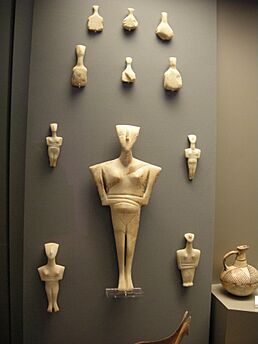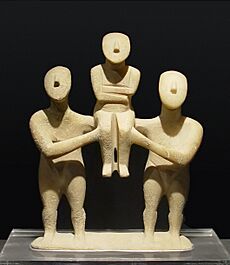Cycladic art facts for kids
The ancient Cycladic culture was a fascinating civilization that lived on the islands of the Aegean Sea a very long time ago, from about 3300 to 1100 BCE. They were one of the three main ancient cultures in the Aegean area, along with the Minoan civilization and Mycenaean Greece. So, Cycladic art is a special part of all Aegean art.
The most famous art from the Cycladic people are their marble figurines. These are usually statues of a single female figure with her arms folded across her chest. Archaeologists call them "FAF" which stands for "folded-arm figure." Most of these figures have a smooth, blank face, except for a clear nose. But some evidence shows they were once painted with bright colors! Many of these figures have been found, but sadly, most were taken illegally from their original burial places.
Contents
Ancient Art from the Cyclades
Almost everything we know about the earliest art from the Cyclades comes from a dig site called Saliagos, near the island of Antiparos. The pottery from this time looks a lot like pottery found in Crete and on the Greek mainland. One special type of pot was a bowl on a tall stand, similar to pots found later on the mainland.
Amazing Marble Sculptures
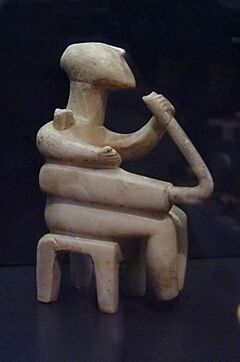
The most well-known art from the Cycladic period are the marble figures. People often call them "idols" or "figurines." But these names aren't quite right. "Idol" suggests they were used for religious worship, which experts aren't sure about. And "figurine" doesn't really fit the largest ones, which are almost life-sized! These marble figures have been found all over the Aegean Sea, showing they were popular even in Crete and mainland Greece.
Some of the most famous figures are musicians. One plays a harp, and another plays pipes. These musician statues are from around 2500 BCE. They are sometimes called "the earliest musicians we know from the Aegean Sea."
Most of these figures are very simple and stylish representations of the female body. They often look flat and geometric. This style influenced some modern artists in the 1900s. However, we now know that many of these sculptures were originally painted in bright colors. Most of the figurines are female, with their arms folded across their stomach. Usually, the right arm is placed below the left.
Some people think these figures represent a "Great Goddess" of nature. They believe this idea might have come from even older female figures, like the Venus of Willendorf. But there's no clear agreement on what these figures meant. Experts have suggested they could be statues of gods, symbols of death, children's dolls, or other things. One expert said they were "more than dolls and probably less than sacred idols."
There is no archaeological proof that these figures were "idols" used for religious worship. What we do know from archaeology is that these figures were often used in burial ceremonies. Almost all of them have been found in graves. But some figures show signs of being repaired. This suggests they were important objects that people valued during their lives, not just made for burial. Sometimes, larger figures were even broken into pieces, and only parts were buried. We don't know why this happened. These figures were buried with both men and women, but not every grave had one. While most sculptures are found lying on their backs in graves, larger ones might have stood in special places or homes.
Early Cycladic Art Periods
Early Cycladic art is divided into three main time periods:
- EC I (2800–2500 BCE)
- EC II (2500–2200 BCE)
- EC III (2200–2000 BCE)
The art styles weren't strictly limited to just one period or island. Art from EC I is mostly found on Paros, Antiparos, and Amorgos. EC II art is mainly seen on Syros, and EC III art on Melos.
Early Cycladic I (Grotta-Pelos Culture, 3300–2700 BCE)
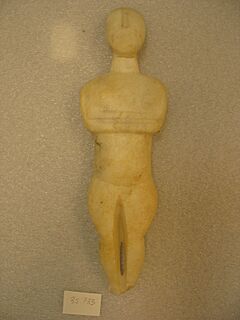
The most important early groups of the Grotta–Pelos culture are called Pelos, Plastiras, and Louros.
- Pelos figurines are very simple and schematic.
- Plastiras figures are more realistic, showing both males and females standing with a head and face.
- Louros figures are a mix, combining simple and realistic styles.
Simple figures are more common. They are very flat and lack a clear head. Realistic figures are small and often have strange or exaggerated body parts, like long necks, angular upper bodies, and strong legs.
Pelos Type (Simple Style)
Pelos type figurines are different because it's often hard to tell if they are male or female. The most famous Pelos figures are shaped like a "violin." They have a long, implied head, no legs, and a body shaped like a violin.
Plastiras Type (Realistic Style)
The Plastiras type is an early example of Cycladic figurines. They are named after a cemetery on Paros where they were found. These figures keep the violin-like shape and folded arms of earlier types. But they are much more realistic. Plastiras figures are known for their exaggerated body parts. They have an oval head with carved facial features, including ears. The neck is very long, often making up one-third of the figure's total height. The legs were carved separately, which often led to them breaking. Male figures are similar but have narrower hips. These figures are usually no bigger than thirty centimeters. They cannot stand on their own because their feet are pointed. Most surviving figures are made of marble, but some might have been carved from wood.

Louros Type (Mixed Style)
The Louros type combines both realistic and simple styles. These figures have blank faces, a long neck, and a simple body with wide shoulders. Their shoulders often extend wider than their hips. The legs are carefully shaped but are only carved apart up to the knees or mid-calves.
Early Cycladic II (Keros-Syros Culture, 2800–2300 BCE)
The Early Cycladic II period is known for the Keros-Syros culture. This period has several distinct styles of figurines.
Spedos Type (Most Common)
The Spedos type is the most common kind of Cycladic figurine. It's named after an Early Cycladic cemetery on Naxos. These figures were found in many places across the Cyclades and were made for a long time. This group includes figures from tiny ones (8 cm tall) to huge sculptures (1.5 meters tall). Except for one male statue, all known Spedos figures are female. Spedos figurines are usually slender, tall female forms with folded arms. They have U-shaped heads and a deep cut between their legs.
Chalandriani Type (Bold Shoulders)
The Chalandriani type comes from the end of the Early Cycladic II period. These figures are named after a cemetery on the island of Syros. They are similar to the Dokathismata type that came before them, but Chalandriani figures have a more cut-off shape.
A special thing about the Chalandriani type is that the strict rule of the right arm being below the left arm was relaxed. Some sculptures have reversed arms, or even no folded arms at all! The reclining (lying down) position of earlier figures also changed. The feet are not always angled, and the legs are somewhat stiff. The shoulders are very wide, even more so than the Dokathismata type. This made the upper arms and shoulders very thin and easy to break. The head is triangular or shield-shaped with few facial features, except for a noticeable nose. It connects to the body with a pyramid-shaped neck. Like other figures, some Chalandriani figures appear to be pregnant. The most important feature of these figures is their bold and very wide shoulders and upper arms.
Pottery and Other Finds
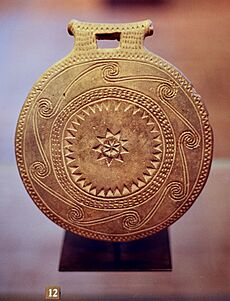
The local clay was hard for artists to work with. Because of this, the pottery, plates, and vases from this period are not always the best quality.
However, some interesting items are the "frying pans." These appeared on the island of Syros during the EC II period. They are round, decorated disks. They weren't used for cooking! Instead, they might have been fertility charms or even mirrors. Some small animal figures and pieces showing ships have also been found.
Besides these, other useful pottery items have been discovered. All early Cycladic pottery was made by hand. It was usually black or reddish, though some pale yellow pottery has also been found. Common shapes include cylindrical boxes called pyxides and jars with collars. They were often roughly made, with thick walls and imperfections. But sometimes they have designs inspired by the sea, which makes sense for island people. There are also small animal figurines made of pottery.
Images for kids
-
Male harp player of the early Spedos type in the Getty Villa
-
Head of a female figure, Spedos type, Keros-Syros culture (EC II, 2700–2300 BCE; Louvre)
-
Early terracotta figurines from Santorini (around 2100 BCE; Museum of Cycladic Culture)
-
Gold figure of an ibex from Santorini, late Cycladic (17th century BCE)
See also
- Akrotiri (prehistoric city) for more art and items found at an ancient Cycladic site.
- Keros-Syros culture
- Grotta–Pelos culture


